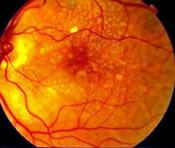Macular Degeneration Disease
Age Related Macular Degeneration (AMD)
Definition of Macular Degeneration

Age related macular degeneration is a common condition affecting patients 50 years and older that may be associated with no vision loss or may be associated with central vision loss such as loss of the ability to read, to drive a car, or see someone’s face. The macula refers to the central portion of the retina or the thin layer of tissue that retains the vision cells in the back of the eye. The retina is similar to film inside a camera. The macula is the central focus point of the retina that allows someone to see fine details such as reading a book. Although age related macular degeneration can cause central vision loss, it does not lead to complete blindness. Many patients with age related macular degeneration have no visual symptoms whatsoever and 20/20 vision. A minority of patients will lose central vision and the ability to read and drive a car.
There are two major types of age related macular degeneration. The dry type is the most common form of AMD and affects 90% of patients. The wet type affects only a small percentage of patients, approximately 10%. However, wet AMD accounts for the majority of central vision loss due to AMD. The wet type implies leakage and bleeding in the macula due to abnormal blood vessels known as choroidal neovascularization (choroidal neovascularization is abnormal blood vessels beneath the macula that leak and bleed and cause central vision loss, blurring of vision, or distortion of vision).
The dry form of AMD is characterized by drusen, and these are little yellow age deposits that are noted in the macula on clinical examination. Drusen are the hallmark of AMD. Most patients with drusen do not have significant visual changes or vision loss, although it is common for patients to note the need for increased lighting, fluctuating vision, or blurred vision. A minority of patients with dry AMD will advance to central vision loss due to geographic atrophy (geographic atrophy is loss of drusen and other tissues in the macula that are required for good central vision). Unfortunately, there is no cure for geographic atrophy.
There is significant interest in the treatment of the wet form of AMD. New treatments are in evolution for wet AMD to try and reduce leakage and bleeding from choroidal neovascularization. Injection therapies or laser therapies are the mainstays of treatment of wet AMD. In 2006, Lucentis was approved by the US FDA and shown to be the first treatment to improve central vision on average in patients with wet AMD.
Causes and Associations of Age Related Macular Degeneration (AMD)
There are no known proven causes of AMD. It is a degenerative condition that occurs over time and is arbitrarily diagnosed in patients 50 years or older, although drusen can be seen in younger patients. There tends to be familial associations, although just because a family member or blood relative has Macular Degeneration does not destine someone to have it as well. Over time, the macula accumulates drusen and pigmentary changes, and if choroidal neovascularization or geographic atrophy is avoided, then vision tends to remain good. In a minority of patients, progression to advanced AMD is observed, characterized by geographic atrophy or choroidal neovascularization (wet AMD) and subsequent central vision loss.
There are modifiable risk factors for patients with AMD: Age Related Macular Degeneration (AMD)
- Stop smoking. Smoking has been associated with vision loss and more advanced forms of AMD.
- Eat a diet rich in colorful vegetables and fruits. These food groups have been associated with less advanced AMD and contain anti-oxidants which may slow progression of disease.
- Control blood pressure. High blood pressure is associated with more advanced vision loss and AMD.
- Consider sources of Omega 3 fatty acids. Omega 3 fatty acids found in cold water fish such as tuna and salmon, or those found in fish oil capsules, are believed to be associated with less advanced AMD.
- Be physically active. Patients with AMD who were physically active several times a week were at reduced risk for advanced AMD and vision loss.
There are many associations of the risk factors of AMD that are similar to risk factors for heart disease. Clearly, a physically active, healthy lifestyle and well balanced nutrition are believed to be good for both your eyes and your heart.

